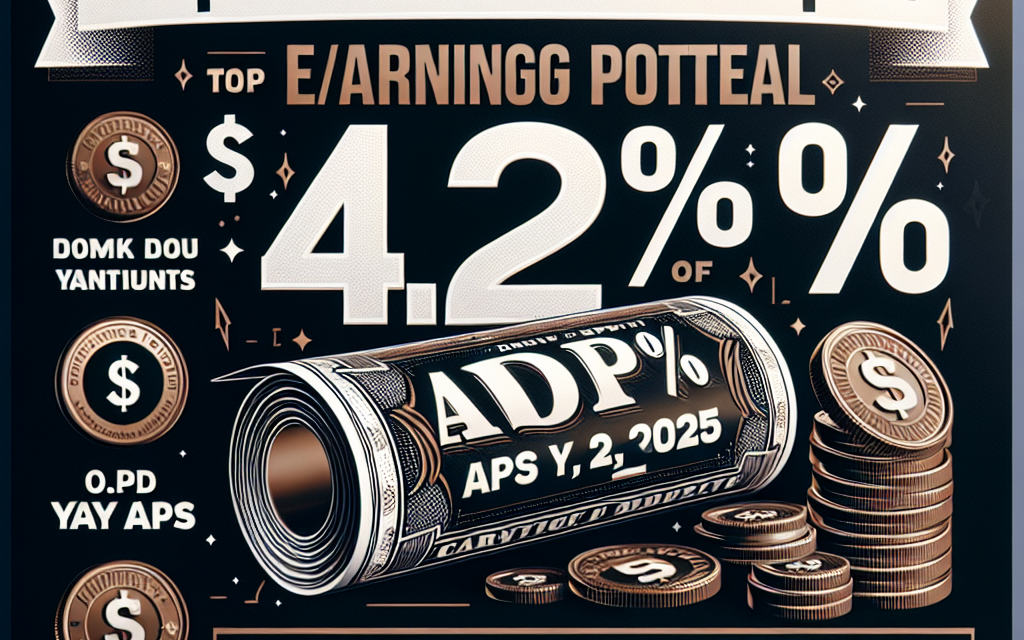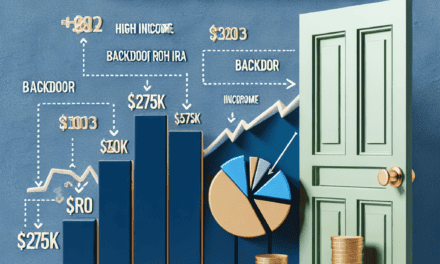“Lock in Your Future: Top CD Rates Up to 4.27% APY for January 8, 2025!”
Introduction
As of January 8, 2025, savers can take advantage of competitive Certificate of Deposit (CD) rates, with some institutions offering annual percentage yields (APY) as high as 4.27%. These top CD rates present an attractive opportunity for individuals looking to secure their savings while earning a solid return. With various terms and conditions available, investors can choose options that best fit their financial goals, whether they prefer short-term commitments or longer investment horizons. This overview highlights the leading CD rates currently available, helping savers make informed decisions to maximize their earnings in a fluctuating interest rate environment.
Top CD Rates for January 2025: A Comprehensive Overview
As we enter January 2025, the landscape of Certificate of Deposit (CD) rates presents an enticing opportunity for savers looking to maximize their returns. With rates reaching as high as 4.27% Annual Percentage Yield (APY), it is essential to explore the various options available to consumers. This comprehensive overview will guide you through the top CD rates currently offered, helping you make informed decisions about your savings strategy.
In recent months, the financial environment has shifted, prompting banks and credit unions to adjust their CD offerings. The competitive nature of the market has led to an increase in rates, making it an opportune time for individuals to consider locking in their funds for a fixed term. Many institutions are now providing attractive rates for both short-term and long-term CDs, catering to a wide range of financial goals and timelines.
For those who prefer shorter commitments, several banks are offering competitive rates on 6-month and 1-year CDs. These options typically provide flexibility, allowing savers to access their funds sooner while still earning a respectable return. For instance, some institutions are advertising rates around 4.00% APY for 1-year CDs, which can be particularly appealing for individuals who may need liquidity in the near future. Additionally, these shorter-term CDs can serve as a stepping stone for savers who wish to reassess their financial situation after a year.
On the other hand, longer-term CDs, such as 2-year and 5-year options, are also gaining traction among consumers. With rates reaching up to 4.27% APY for 5-year CDs, these products can be an excellent choice for those willing to commit their funds for an extended period. The higher rates associated with longer terms often reflect the increased risk of locking in funds, but for many savers, the potential for greater returns outweighs this concern. Furthermore, these longer-term CDs can provide a sense of security, as they offer a guaranteed return over the investment period.
It is also worth noting that credit unions are increasingly competitive in the CD market, often providing rates that rival those of traditional banks. Many credit unions offer membership to a broad audience, making it easier for consumers to take advantage of these attractive rates. By exploring both banks and credit unions, savers can ensure they are getting the best possible return on their investments.
As you consider your options, it is crucial to evaluate the terms and conditions associated with each CD. Factors such as minimum deposit requirements, early withdrawal penalties, and compounding frequency can significantly impact your overall returns. Additionally, some institutions may offer promotional rates that are only available for a limited time, so it is advisable to act quickly if you find an appealing offer.
In conclusion, January 2025 presents a favorable environment for savers looking to invest in CDs, with rates reaching up to 4.27% APY. By carefully comparing the offerings from various banks and credit unions, individuals can find the right CD that aligns with their financial goals. Whether opting for a short-term or long-term commitment, the current landscape provides ample opportunities to grow your savings effectively. As always, it is prudent to conduct thorough research and consider your personal financial situation before making any investment decisions.
How to Choose the Best CD for Your Financial Goals
When considering how to choose the best Certificate of Deposit (CD) for your financial goals, it is essential to understand the various factors that can influence your decision. A CD is a time deposit offered by banks and credit unions that typically provides a higher interest rate than traditional savings accounts in exchange for locking in your funds for a specified period. As you explore your options, the first step is to assess your financial objectives. Are you saving for a short-term goal, such as a vacation or a down payment on a home, or are you looking for a long-term investment to grow your wealth? Your timeline will significantly impact the type of CD that best suits your needs.
Once you have established your financial goals, the next consideration is the interest rate. As of January 8, 2025, some institutions are offering rates as high as 4.27% APY, which can be quite attractive compared to other savings vehicles. However, it is crucial to compare rates from multiple banks and credit unions, as they can vary significantly. Online banks often provide more competitive rates than traditional brick-and-mortar institutions, so expanding your search to include these options may yield better returns. Additionally, be mindful of the compounding frequency, as more frequent compounding can enhance your overall earnings.
In conjunction with interest rates, the term length of the CD is another vital factor to consider. CDs come in various terms, ranging from a few months to several years. Generally, longer terms offer higher interest rates, but they also require you to commit your funds for an extended period. If you anticipate needing access to your money sooner rather than later, a shorter-term CD may be more appropriate, even if it offers a lower rate. Conversely, if you can afford to lock away your funds for a longer duration, you might benefit from the higher yields associated with longer-term CDs.
Another important aspect to evaluate is the penalties for early withdrawal. Most CDs impose penalties if you withdraw your funds before the maturity date, which can significantly diminish your earnings. Therefore, it is prudent to read the fine print and understand the terms associated with early withdrawal penalties. Some institutions offer no-penalty CDs, which allow you to access your funds without incurring fees, providing greater flexibility should your financial situation change.
Furthermore, consider the institution’s reputation and customer service. Researching customer reviews and ratings can provide insight into the bank’s reliability and the quality of its services. A trustworthy institution will not only safeguard your funds but also offer support should you have questions or concerns regarding your account.
Lastly, it is wise to evaluate any additional features or benefits that may come with the CD. Some banks offer promotional rates, loyalty bonuses, or the option to add funds during the term. These features can enhance your overall experience and potentially increase your returns.
In conclusion, choosing the best CD for your financial goals involves a careful assessment of your objectives, interest rates, term lengths, early withdrawal penalties, and the institution’s reputation. By taking the time to evaluate these factors, you can make an informed decision that aligns with your financial aspirations, ultimately maximizing your savings potential in a competitive market.
Understanding APY: What Does 4.27% Mean for You?
When considering the best options for saving and investing, understanding the concept of Annual Percentage Yield (APY) is crucial, especially in the context of the top Certificate of Deposit (CD) rates available as of January 8, 2025. With rates reaching as high as 4.27% APY, it is essential to grasp what this figure signifies and how it can impact your financial decisions. APY represents the real rate of return on your investment, taking into account the effect of compounding interest over a year. Therefore, a 4.27% APY means that if you invest a certain amount in a CD, you can expect to earn 4.27% on that investment over the course of one year, assuming the interest is compounded annually.
To illustrate, if you were to deposit $10,000 into a CD with a 4.27% APY, you would earn approximately $427 in interest by the end of the year, bringing your total balance to $10,427. This straightforward calculation highlights the appeal of high APY rates, particularly in a low-interest-rate environment where traditional savings accounts may offer significantly lower returns. Moreover, the compounding effect can further enhance your earnings, especially if you choose a CD with more frequent compounding intervals, such as monthly or quarterly. In such cases, your interest would be calculated on both your initial deposit and any interest that has already been added to your account, leading to potentially higher overall returns.
It is also important to consider the implications of locking your funds into a CD. While the attractive APY can be enticing, CDs typically require you to commit your money for a specified term, which can range from a few months to several years. During this period, accessing your funds may incur penalties, which could diminish the benefits of the high APY. Therefore, it is vital to assess your financial situation and liquidity needs before committing to a CD. If you anticipate needing access to your funds in the near future, a high APY may not outweigh the potential costs associated with early withdrawal.
Furthermore, comparing different CD offerings is essential to ensure you are making the most informed decision. While a 4.27% APY may be the highest available rate, other factors such as the term length, minimum deposit requirements, and the financial institution’s reputation should also be taken into account. Some banks may offer promotional rates that are only available for a limited time or may have specific conditions attached. Therefore, conducting thorough research and comparing various options can help you find the best fit for your financial goals.
In conclusion, understanding what a 4.27% APY means for you is fundamental in navigating the landscape of savings and investments. This rate not only reflects the potential earnings on your investment but also underscores the importance of considering your financial needs and the terms associated with a CD. By weighing the benefits of high APY rates against the commitment required, you can make a more informed decision that aligns with your overall financial strategy. As you explore the top CD rates available, remember that knowledge is key to maximizing your savings potential and achieving your financial objectives.
Comparing Short-Term vs. Long-Term CD Rates
When considering the best options for investing in certificates of deposit (CDs), it is essential to understand the differences between short-term and long-term CD rates. As of January 8, 2025, the financial landscape offers a variety of rates, with some institutions providing yields as high as 4.27% APY. However, the choice between short-term and long-term CDs can significantly impact your overall returns and financial strategy.
Short-term CDs typically have maturities ranging from three months to one year. These investment vehicles are appealing for those who prefer liquidity and flexibility. Investors who opt for short-term CDs can take advantage of rising interest rates, as they can reinvest their funds more frequently. For instance, if interest rates increase after a short-term CD matures, investors can secure a higher rate on their next investment. This adaptability is particularly beneficial in a fluctuating economic environment, where market conditions can change rapidly. Furthermore, short-term CDs often come with lower penalties for early withdrawal, making them a safer choice for individuals who may need access to their funds sooner rather than later.
On the other hand, long-term CDs generally have maturities that extend beyond one year, often ranging from two to five years or more. These CDs typically offer higher interest rates compared to their short-term counterparts, which can be an attractive option for those looking to maximize their returns over a longer period. The trade-off, however, is that investors must commit their funds for an extended duration, which can limit their financial flexibility. In a stable or declining interest rate environment, locking in a higher rate for a longer term can be advantageous, as it protects the investor from potential future rate drops. However, if interest rates rise significantly during the term of the CD, investors may find themselves missing out on better opportunities.
Moreover, the choice between short-term and long-term CDs can also be influenced by individual financial goals and risk tolerance. For conservative investors who prioritize capital preservation and are less concerned about maximizing returns, long-term CDs can provide a sense of security. Conversely, those who are more risk-averse and prefer to maintain access to their funds may lean towards short-term CDs. It is also worth noting that some financial institutions offer promotional rates for both short-term and long-term CDs, which can further complicate the decision-making process. Therefore, it is crucial to compare the specific terms and conditions of each option before making a commitment.
In conclusion, the decision between short-term and long-term CD rates ultimately hinges on an investor’s financial objectives, market outlook, and personal circumstances. While short-term CDs offer flexibility and the potential for reinvestment at higher rates, long-term CDs provide the opportunity for higher yields in exchange for a longer commitment. As the financial landscape continues to evolve, staying informed about current rates and trends will empower investors to make the most suitable choice for their unique situations. By carefully weighing the benefits and drawbacks of each option, individuals can strategically position themselves to achieve their financial goals while navigating the complexities of the CD market.
The Benefits of Locking in High CD Rates Now
As we enter January 2025, the financial landscape presents a unique opportunity for savers to capitalize on high Certificate of Deposit (CD) rates, with some institutions offering annual percentage yields (APY) as high as 4.27%. In an environment where interest rates are subject to fluctuations, locking in these elevated rates now can provide significant advantages for individuals looking to grow their savings securely.
One of the primary benefits of securing a high CD rate is the predictability it offers. Unlike other investment vehicles that may be subject to market volatility, CDs provide a fixed interest rate for the duration of the term. This means that once you deposit your funds, you can rest assured that your earnings will remain stable, allowing for better financial planning and budgeting. For those who prioritize security and certainty in their financial strategies, this characteristic of CDs is particularly appealing.
Moreover, the current economic climate, characterized by rising interest rates, suggests that now may be an opportune moment to lock in a high rate. As central banks adjust their monetary policies in response to inflationary pressures, the potential for future rate increases or decreases could impact the yields offered by CDs. By securing a high rate today, savers can protect themselves against the uncertainty of future interest rate movements. This proactive approach not only safeguards their investment but also maximizes potential returns over the term of the CD.
In addition to the stability and predictability that CDs offer, they also serve as an effective tool for disciplined saving. Committing funds to a CD requires individuals to set aside their money for a predetermined period, which can help cultivate a habit of saving. This is particularly beneficial for those who may struggle with the temptation to dip into their savings for non-essential expenses. By choosing a CD with a term that aligns with their financial goals, savers can create a structured savings plan that encourages long-term financial health.
Furthermore, the current high CD rates can be particularly advantageous for individuals nearing retirement or those who are already retired. As these individuals often seek to preserve their capital while generating income, the fixed returns offered by CDs can provide a reliable source of interest income. This is especially important in a low-yield environment where traditional savings accounts may not offer sufficient returns to keep pace with inflation. By locking in a high CD rate, retirees can enhance their income stream while minimizing risk.
It is also worth noting that many financial institutions are offering promotional rates on CDs, which can further enhance the appeal of this savings vehicle. These promotional rates may be available for limited periods or specific terms, encouraging savers to act quickly to take advantage of the higher yields. As such, individuals should conduct thorough research and compare offerings from various banks and credit unions to ensure they are securing the best possible rate.
In conclusion, the benefits of locking in high CD rates now are manifold. From the predictability and security they provide to the disciplined savings habits they encourage, high CD rates present a compelling opportunity for savers. As the financial landscape continues to evolve, taking advantage of these rates can lead to enhanced financial stability and growth, making it a prudent choice for those looking to maximize their savings in 2025 and beyond.
Tips for Maximizing Your Earnings with CDs
When considering how to maximize your earnings with certificates of deposit (CDs), it is essential to understand the various strategies that can enhance your returns. As of January 8, 2025, the competitive landscape of CD rates offers opportunities to earn up to 4.27% APY, making it a prudent time to explore these options. One of the first steps in maximizing your earnings is to shop around for the best rates. Financial institutions often vary significantly in the interest rates they offer, so taking the time to compare rates from different banks and credit unions can yield substantial benefits. Online banks, in particular, tend to provide higher rates due to their lower overhead costs, making them a worthwhile consideration.
In addition to comparing rates, it is crucial to pay attention to the terms of the CDs. Longer-term CDs typically offer higher interest rates, but they also require you to lock in your funds for an extended period. Conversely, shorter-term CDs provide more flexibility but may offer lower rates. Therefore, it is advisable to assess your financial goals and liquidity needs before committing to a specific term. If you anticipate needing access to your funds in the near future, a shorter-term CD may be more appropriate, even if it means accepting a lower rate.
Another effective strategy for maximizing earnings is to consider laddering your CDs. This approach involves dividing your investment across multiple CDs with varying maturity dates. By doing so, you can take advantage of higher rates on longer-term CDs while still maintaining access to some of your funds at regular intervals. For instance, you might invest in CDs that mature in one, two, three, and five years. As each CD matures, you can reinvest the principal into a new long-term CD, potentially capturing higher rates as they become available.
Moreover, it is essential to be aware of any penalties associated with early withdrawals. Most CDs impose penalties if you withdraw your funds before the maturity date, which can significantly diminish your overall earnings. Therefore, it is wise to ensure that you will not need to access your funds during the term of the CD. If you are uncertain about your future liquidity needs, consider opting for a no-penalty CD, which allows for early withdrawal without incurring fees, albeit often at a lower interest rate.
Additionally, keep an eye on promotional offers from financial institutions. Many banks and credit unions run limited-time promotions that can provide higher rates for new customers or specific deposit amounts. Taking advantage of these promotions can significantly enhance your earnings, especially if you are willing to open new accounts or meet certain deposit thresholds.
Lastly, it is important to stay informed about changes in interest rates and economic conditions. The financial landscape can shift rapidly, and being aware of these changes can help you make timely decisions regarding your investments. By regularly reviewing your CD portfolio and considering reinvestment options, you can ensure that your money continues to work for you effectively.
In conclusion, maximizing your earnings with CDs requires a combination of strategic planning, diligent research, and an understanding of your financial needs. By comparing rates, considering terms, employing a laddering strategy, being mindful of penalties, and taking advantage of promotional offers, you can optimize your returns in this competitive interest rate environment. As you navigate the world of CDs, staying informed and proactive will ultimately lead to greater financial success.
Future Trends: What to Expect from CD Rates in 2025
As we look ahead to 2025, the landscape of Certificate of Deposit (CD) rates is poised for significant evolution, influenced by a variety of economic factors and monetary policies. The current trend of rising interest rates, which has characterized the latter part of 2023 and into 2024, is expected to continue shaping the financial environment. Consequently, consumers and investors alike are keenly interested in understanding what to expect from CD rates in the coming year.
One of the primary drivers of CD rates is the Federal Reserve’s monetary policy. As the Fed adjusts its benchmark interest rates in response to inflationary pressures and economic growth, these changes ripple through the banking system, affecting the rates offered on CDs. If the Fed maintains a hawkish stance to combat inflation, we may see CD rates continue to rise, potentially reaching or exceeding the current high of 4.27% APY. This scenario would be particularly beneficial for savers looking to maximize their returns in a low-risk investment vehicle.
Moreover, the competitive landscape among financial institutions is another crucial factor influencing CD rates. As banks and credit unions strive to attract deposits, they may offer more attractive rates to entice customers. This competition can lead to a favorable environment for consumers, as institutions may be willing to provide higher yields to secure funds. Therefore, it is reasonable to anticipate that savvy savers will find opportunities to lock in competitive rates throughout 2025.
In addition to these economic indicators, consumer behavior will also play a role in shaping CD rates. As individuals become more aware of the benefits of saving and investing, there may be an increased demand for CDs as a safe haven for funds. This heightened interest could prompt financial institutions to adjust their offerings accordingly, potentially leading to more favorable rates for consumers. Furthermore, as the economy stabilizes and individuals regain confidence in their financial futures, we may see a shift towards longer-term CDs, which typically offer higher rates than their shorter-term counterparts.
Another trend to consider is the impact of digital banking and fintech companies on the CD market. These institutions often operate with lower overhead costs and can pass those savings onto consumers in the form of higher interest rates. As digital banking continues to gain traction, traditional banks may feel pressured to enhance their CD offerings to remain competitive. This dynamic could lead to a broader range of options for consumers, including innovative products that cater to varying financial goals and risk tolerances.
Looking ahead, it is also essential to consider the potential for economic fluctuations that could influence CD rates. Factors such as geopolitical events, changes in consumer spending, and shifts in global markets can all impact the financial landscape. Should economic uncertainty arise, it is possible that rates could stabilize or even decline as banks adjust their strategies in response to changing conditions.
In conclusion, the outlook for CD rates in 2025 appears promising, with the potential for continued growth driven by Federal Reserve policies, competitive banking practices, and evolving consumer preferences. As savers navigate this landscape, staying informed about market trends and available options will be crucial in making the most of their investment choices. By understanding these dynamics, consumers can position themselves to take advantage of the best CD rates available, ensuring their savings work effectively for them in the years to come.
Q&A
1. **What are CD rates?**
CD rates refer to the interest rates offered on Certificates of Deposit, which are time deposits held at banks or credit unions.
2. **What is the highest CD rate available as of January 8, 2025?**
The highest CD rate available is up to 4.27% APY.
3. **What does APY stand for?**
APY stands for Annual Percentage Yield, which reflects the total amount of interest earned on a deposit account over a year, taking into account compounding.
4. **Are CD rates fixed or variable?**
CD rates are typically fixed for the term of the deposit.
5. **What is the typical term length for CDs offering high rates?**
High-rate CDs often have term lengths ranging from 6 months to 5 years.
6. **Is there a penalty for early withdrawal from a CD?**
Yes, most CDs impose a penalty for early withdrawal, which can vary by institution.
7. **How can I find the best CD rates?**
You can find the best CD rates by comparing offers from various banks and credit unions, using financial comparison websites, or checking with your local financial institutions.
Conclusion
As of January 8, 2025, top CD rates offer competitive yields, with some institutions providing annual percentage yields (APY) as high as 4.27%. This presents a favorable opportunity for savers seeking to maximize their returns in a stable investment vehicle. Investors should consider factors such as term length, minimum deposit requirements, and early withdrawal penalties when selecting a CD to ensure it aligns with their financial goals. Overall, these rates reflect a positive trend in the fixed-income market, making CDs an attractive option for conservative investors.





